Neptune Holidays - Bhutan make travel easy by crafting each and every tour as per the needs and requirements of the guests. We specialize in Bhutan travel and ensure a perfect holiday in Bhutan for every guests we serve. We are based in the Capital City, Thimphu and all of us in the Company work with one main objective; "the happiness of our guests". Being born and brought up in a country where happiness matters more than the material wealth, our mantra is to ensure that all of our guests are happy and have a life time experience while travelling in Bhutan.
We are certified by the Tourism Council of Bhutan and are also a member of the Association of Bhutanese tour operators. Our team consists of dedicated and experienced Bhutan travel specialists having in-depth knowledge of tourism in Bhutan. We are available to respond to your Bhutan travel needs 24 x 7.
Thank you visiting our website and we look forward to fulfill your Bhutan travel requirements with utmost satisfaction. Come and explore, one of the world's best kept secret with us.
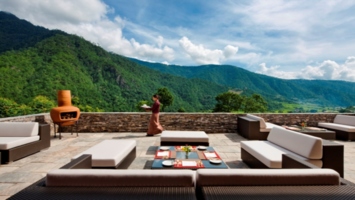
Bhutan, ‘The Land of the Thunder Dragon’, is the last independent Himalayan kingdom and a stronghold of Tibetan Buddhism. It is the only country in the world where Vajrayana Buddhism is a way of everyday life. To the local people traditional values, environmental preservation and good governance takes precedence over material things. It is considered to be one of the happiest countries of the world. The landscape of Bhutan is full of mountainous valleys, glacial rivers, and terraced rice fields. One is Bhutan don’t forget to join in the cheese fanaticism that is everywhere by ordering your own plate – be it chilli cheese, cauliflower with cheese, or broccoli with cheese!
Brief Description of Cities covered in this tour:
Thimphu: Capital and the largest city of Bhutan - Only capital city in the world that does not have traffic lights - Main center of Commerce, Religion and Government in the country - Most modern city of Bhutan and has abundance of restaurants, internet cafes, nightclubs and shopping center. It is one of the few cities of Bhutan having ATM facilities.
Paro: Small town in the western part of Bhutan - Also home to Paro Airport, Bhutan’s only International Airport - The valley has many isolated small villages and is known for red rice - Also home to most of Bhutan’s oldest temples and monasteries.
Punakha and Wangdue: Punakha and Wangdue is located in the same valley. These two places are located within a distance of 13 km. Punakha was the capital of Bhutan and the seat of government until 1955 - The valley is fed by the Pho Chhu and the Mo Chhu rivers - It is one of very few places in Bhutan which offers Rafting facilities - It is the winter seat of the Je Khenpo (Chief Abbot) and the monk body at present.
Gangtey/Phobjikha: The famous Phobjikha Valley is located in Wangdue district, 68 km away from the Wangdue valley- Phobjikha is the winter roosting place for endangered black necked crane and the valley is considered one of the most beautiful glacial valleys in the Himalayas.
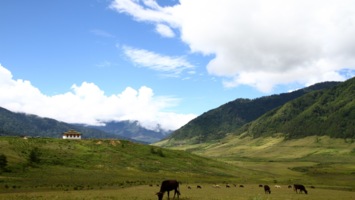
Visiting Bhutan is like taking a breath of fresh air filled with purity. The landscape is full of beautiful mountainous valleys, plunging rivers, and terraced rice fields. It’s a country that not only has monarchy but also a newborn democracy. Bhutan is most famous for the “Gross National Happiness” in the tourism literature because their strive for growth and progress based on peace and happiness. With customs and traditions still going strong after centuries, and cultural festivals celebrated from corner to corner, there is nowhere quite like blessed Bhutan!
Brief Description of Cities covered in this tour:
Thimphu: Capital and the largest city of Bhutan - Only capital city in the world that does not have traffic lights - Main center of Commerce, Religion and Government in the country - Most modern city of Bhutan and has abundance of restaurants, internet cafes, nightclubs and shopping center. It is one of the few cities of Bhutan having ATM facilities.
Paro: Small town in the western part of Bhutan - Also home to Paro Airport, Bhutan’s only International Airport - The valley has many isolated small villages and is known for red rice - Also home to most of Bhutan’s oldest temples and monasteries.
Punakha and Wangdue: Punakha and Wangdue is located in the same valley. These two places are located within a distance of 13 km. Punakha was the capital of Bhutan and the seat of government until 1955 - The valley is fed by the Pho Chhu and the Mo Chhu rivers - It is one of very few places in Bhutan which offers Rafting facilities - It is the winter seat of the Je Khenpo (Chief Abbot) and the monk body at present.
Gangtey/Phobjikha: The famous Phobjikha Valley is located in Wangdue district, 68 km away from the Wangdue valley- Phobjikha is the winter roosting place for endangered black necked crane and the valley is considered one of the most beautiful glacial valleys in the Himalayas.
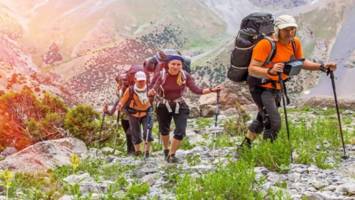
The Nabji Trail is an ideal posy-harvest/winter trekking set out in Jigme Singye Wangchuck National Park. This trek offers a short, easy and enjoyable journey around scenic Trongsa Dzongkha. It is also the first community-run eco-trek in Bhutan to offer it. This is a low-altitude trek in pretty Bhutanese farmland and forest, and therefore altitude is not an issue. This trek also helped improve the living standard of people by providing alternative means of sustainable livelihoods,”. Your travel will give rural communities additional source of income to supplement their livelihood from subsistence farming.
The Nabji- Korphu trails takes you through 6 rural communities. You can immerse yourself in the daily lives and farming chores of the local communities while helping them to conserve environment as well as their cultural and historical heritage. The climate is warm and pleasant as the trail ranges between 1000m -1500m in altitude and there is a wide variety of flora and fauna. You will get a chance experiencing traditional rural life firsthand while enjoying natural beauty of Bhutan. The best time to embark on this trek is in winter, between October – April.
Brief Description of Cities covered in this tour
Thimphu: Capital and the largest city of Bhutan - Only capital city in the world that does not have traffic lights - Main center of Commerce, Religion and Government in the country - Most modern city of Bhutan and has abundance of restaurants, internet cafes, nightclubs and shopping center. It is one of the few cities of Bhutan having ATM facilities.
Paro: Small town in the western part of Bhutan - Also home to Paro Airport, Bhutan’s only International Airport - The valley has many isolated small villages and is known for red rice - Also home to most of Bhutan’s oldest temples and monasteries.
Punakha and Wangdue: Punakha and Wangdue is located in the same valley. These two places are located within a distance of 13 km. Punakha was the capital of Bhutan and the seat of government until 1955 - The valley is fed by the Pho Chhu and the Mo Chhu rivers - It is one of very few places in Bhutan which offers Rafting facilities - It is the winter seat of the Je Khenpo (Chief Abbot) and the monk body at present.
Gangtey/Phobjikha: The famous Phobjikha Valley is located in Wangdue district - Phobjikha is the winter roosting place for endangered black necked crane and the valley is considered one of the most beautiful glacial valleys in the Himalayas.
Trongsa: Also known as the Vanguard of the Warriors - The first and Second Kings of Bhutan ruled Bhutan from Trongsa - The Crown Prince normally holds the position of the Trongsa Penlop before ascending to the Throne.
Bumthang: Bumthang District is one of the 20 districts comprising Bhutan - The most historic dzongkhag if the number of ancient temples and sacred sites is counted - Consists of the four mountain valleys of Ura, Chumey, Tang and Choekhor, although occasionally the entire district is referred to as Bumthang valley - Literally, Bumthang directly translates to "beautiful field". "Bum" is said to be the abbreviation for either "Bumpa" (a vessel for holy water) describing the shape and the nature of the Valley, or simply "Bum" meaning Girl, thang means field or ground.
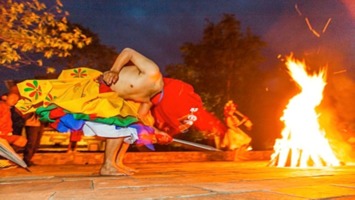
Festivals in Bhutan are rich and happy expressions of its ancient Buddhist culture. These festivals are held in all districts in honor of Guru Rinpoche, the saint who introduced Buddhism to Bhutan in the 8th century. Tshechus are held on auspicious days and months in the Bhutanese calendar, and usually last up to four days in which a series of highly stylized masked dance rituals are performed. Jambay Lhakhang Drup that lasts for four days is held in the month of November. The highlight of the festival is the fire ritual that is held in the evening where crowds gather to witness the ritual together with the naked dance. This Four - Day festival is held in the premises of 7th century Jambay Lhakhang temple in Jakar is to commemorate an establishment of Jambay Lhakhang temple in 7th century and also to honor Guru Rinpoche. In addition to the traditional mask dances performed elsewhere, there are few dances unique here. The festival dances were composed mostly by Terton Pema Lingpa, the great treasure discoverer of the 15th century, who lived in the valley.
Brief Description of Cities covered in this tour:
Thimphu: Capital and the largest city of Bhutan - Only capital city in the world that does not have traffic lights - Main center of Commerce, Religion and Government in the country - Most modern city of Bhutan and has abundance of restaurants, internet cafes, nightclubs and shopping center. It is one of the few cities of Bhutan having ATM facilities.
Paro: Small town in the western part of Bhutan - Also home to Paro Airport, Bhutan’s only International Airport - The valley has many isolated small villages and is known for red rice - Also home to most of Bhutan’s oldest temples and monasteries.
Punakha and Wangdue: Punakha and Wangdue is located in the same valley. These two places are located within a distance of 13 km. Punakha was the capital of Bhutan and the seat of government until 1955 - The valley is fed by the Pho Chhu and the Mo Chhu rivers - It is one of very few places in Bhutan which offers Rafting facilities - It is the winter seat of the Je Khenpo (Chief Abbot) and the monk body at present.
Gangtey/Phobjikha: The famous Phobjikha Valley is located in Wangdue district - Phobjikha is the winter roosting place for endangered black necked crane and the valley is considered one of the most beautiful glacial valleys in the Himalayas.
Trongsa: Also known as the Vanguard of the Warriors - The first and Second Kings of Bhutan ruled Bhutan from Trongsa - The Crown Prince normally holds the position of the Trongsa Penlop before ascending to the Throne.
Bumthang: Bumthang District is one of the 20 districts comprising Bhutan - The most historic dzongkhag if the number of ancient temples and sacred sites is counted - Consists of the four mountain valleys of Ura, Chumey, Tang and Choekhor, although occasionally the entire district is referred to as Bumthang valley - Literally, Bumthang directly translates to "beautiful field". "Bum" is said to be the abbreviation for either "Bumpa" (a vessel for holy water) describing the shape and the nature of the Valley, or simply "Bum" meaning Girl, thang means field or ground.
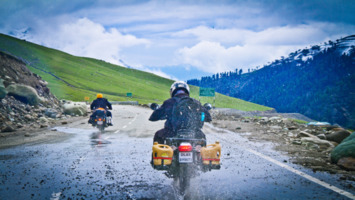
Eastern Bhutan is one of the least explored regions of the kingdom and offers one of most authentic experiences for adventure-oriented tourists. The entire region is awash in unspoiled natural beauty, towering cliffs and pristine forests with great variations in altitude and climatic conditions. It is one of the longest trip. As you ride, you would notice that in Bhutan Buddhism is everywhere. Countless prayer flags, stupas and monasteries demonstrate the importance of spirituality in Bhutan. During the journey we encounter not only warm, mostly good-humored people, but also to explore a sensational mountain scenery, lush green forests and wide valleys with fertile rice terraces. Here you would ride across virgin forests, valleys and mountains. During the entire tour, you would enjoy excellent view of the Himalayas, soak in the culture of Bhutan, opportunity to interact with the locals and do lot more. The trip also takes you to some of the most popular tourist attractions in the kingdom and complements your motorcycling experience with an indulging cultural treat with something for everyone – a glimpse of living culture and traditions, rich history, medieval fortresses, stunning bio-diversity, panoramic views over the Himalayas, friendly locals and rural lifestyles etc. Great riding during the day, and cozy evenings in comfortable hotels, campsites and local farmhouses is the crux of this riding experience. In short, it’s the perfect cultural experience on wheels.
Riders should have an adequate level of fitness and stamina and be experienced enough in the art of mountain biking. Tours are fully supported by a van following riders. The van allows riders the option to sit in and take a break.
Brief Description of Cities covered in this tour
Phuentsholing: Border Town of Southern Bhutan - Has Headquarters of Bank of Bhutan.
Thimphu: Capital and the largest city of Bhutan - Only capital city in the world that does not have traffic lights - Main center of Commerce, Religion and Government in the country - Most modern city of Bhutan and has abundance of restaurants, internet cafes, nightclubs and shopping center. It is one of the few cities of Bhutan having ATM facilities.
Paro: Small town in the western part of Bhutan - Also home to Paro Airport, Bhutan’s only International Airport - The valley has many isolated small villages and is known for red rice - Also home to most of Bhutan’s oldest temples and monasteries.
Punakha and Wangdue: Punakha and Wangdue is located in the same valley. These two places are located within a distance of 13 km. Punakha was the capital of Bhutan and the seat of government until 1955 - The valley is fed by the Pho Chhu and the Mo Chhu rivers - It is one of very few places in Bhutan which offers Rafting facilities - It is the winter seat of the Je Khenpo (Chief Abbot) and the monk body at present.
Gangtey/Phobjikha: The famous Phobjikha Valley is located in Wangdue district - Phobjikha is the winter roosting place for endangered black necked crane and the valley is considered one of the most beautiful glacial valleys in the Himalayas.
Trongsa: Also known as the Vanguard of the Warriors - The first and Second Kings of Bhutan ruled Bhutan from Trongsa - The Crown Prince normally holds the position of the Trongsa Penlop before ascending to the Throne.
Bumthang: Bumthang District is one of the 20 districts comprising Bhutan - The most historic dzongkhag if the number of ancient temples and sacred sites is counted - Consists of the four mountain valleys of Ura, Chumey, Tang and Choekhor, although occasionally the entire district is referred to as Bumthang valley - Literally, Bumthang directly translates to "beautiful field". "Bum" is said to be the abbreviation for either "Bumpa" (a vessel for holy water) describing the shape and the nature of the Valley, or simply "Bum" meaning Girl, thang means field or ground.
Mongar: Covers an area of 1,954 sq. kms and ranges from 400 m to 4,000 m in altitude - Deep Gorges and stark cliffs amidst dense conifer forest constitute its landscapes and the landscape is spectacular with stark cliffs and deep gorges set amidst dense conifer forests - The road to Mongar is one of the most adventurous and spectacular. The sheer cliffs, beautiful fir forest and green pastures constitutes the environment as you drive to Mongar - The area also gives the opportunity to see countless varieties of rhododendrons and on clear days the view of the mountain Gangkar Puensum, (7541 meters), the world's highest unclimbed mountain, is a great experience.
Trashigang: Situated on the banks of the Gamri Chhu and is the country's largest district - It is the junction which connects Samdrupjongkhar in the Southeast Bhutan and the central and western districts - Trashigang is the eastern terminus of the Lateral Road, Bhutan's main highway leading to Phuntsholing in the southwest.
Trashiyangtse: Is a rapidly growing town and administrative center of the district - The main town is situated in a small river valley and is a lovely spot to take walks in the countryside - This area is famous for wooden containers and bowls.
Samdrupjongkhar: Samdrup Jongkhar town holds the distinct honor of being the oldest town in Bhutan - This border town is a bustling little settlement packed to the brim with shopkeepers and hawkers from across the border - The town is located at the south-eastern part of Bhutan and borders the Indian state of Assam
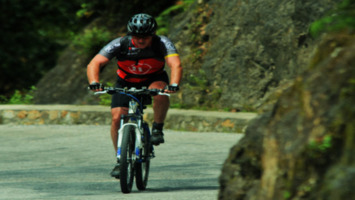
Going on a Bhutan biking tour is probably one of the best ways to explore the wealth of natural beauty that is hidden in the midst of the forests and the mountain ranges. Taking a tour of the terrain on the bike will help you meet the flora and the fauna first hand without any barrier and also rejuvenate yourself with the freshness of the air. You climb through orchards, blue pine forests, browsing at road side stalls selling chilies, apple etc. The trip gives an option of plenty of long mountain climbs and descents, so a good level of cycling fitness is needed. Apart from this rich natural beauty, the challenging cycling provides you with an insight into the rich traditional culture of Bhutan.
Brief Description of Cities covered in this tour
Thimphu: Capital and the largest city of Bhutan - Only capital city in the world that does not have traffic lights - Main center of Commerce, Religion and Government in the country - Most modern city of Bhutan and has abundance of restaurants, internet cafes, nightclubs and shopping center. It is one of the few cities of Bhutan having ATM facilities.
Paro: Small town in the western part of Bhutan - Also home to Paro Airport, Bhutan’s only International Airport - The valley has many isolated small villages and is known for red rice - Also home to most of Bhutan’s oldest temples and monasteries.
Punakha and Wangdue: Punakha and Wangdue is located in the same valley. These two places are located within a distance of 13 km. Punakha was the capital of Bhutan and the seat of government until 1955 - The valley is fed by the Pho Chhu and the Mo Chhu rivers - It is one of very few places in Bhutan which offers Rafting facilities - It is the winter seat of the Je Khenpo (Chief Abbot) and the monk body at present.
Gangtey/Phobjikha: The famous Phobjikha Valley is located in Wangdue district, 68 km away from the Wangdue valley- Phobjikha is the winter roosting place for endangered black necked crane and the valley is considered one of the most beautiful glacial valleys in the Himalayas.
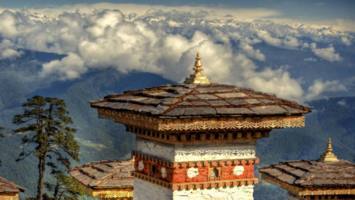
Guru Padmasambhava (meaning "Lotus-Born") also known as Guru Rinpoche, was an 8th-century Indian Buddhist master. He is widely believed to be the 'second Buddha' across Tibet, Nepal, Bhutan, and the Himalayan states of India. He during his lifetime had made three visits to Bhutan.
His first visit was in the year 746 when he was invited to Bhutan to heal the ill Sindha Gyab, the ruler of Bumthang. His visit led to the spread of the Nyingmapa school of Tibetan Buddhism. The second visit was from Tibet through Singye Dzong in Lhuntse. From Singye Dzong, Guru, in his wrathful form of Dorji Drolo, he flew to Taktsang in Paro on the back of a tigress. He meditated there for three months and subdued the demon. His third visit was not very significant as it was just to put in exile Khikharathoed, the Dog mouth and goat skull king who was anti-Buddhist. The Guru banished him beyond Tibetan Border.
This tour covers various places associated with Guru Rimpoche in Bhutan along with other key sacred places. Also in this itinerary, you would be visiting some of the other holy places in Bhutan. Apart from the holy places, you would also visit the other renowned sightseeings. This is a spiritual tour and by the end of it, you would truly feel blessed.
Brief Description of Cities
Thimphu: Capital and the largest city of Bhutan - Only capital city in the world that does not have traffic lights - Main center of Commerce, Religion and Government in the country - Most modern city of Bhutan and has abundance of restaurants, internet cafes, nightclubs and shopping center. It is one of the few cities of Bhutan having ATM facilities.
Paro: Small town in the western part of Bhutan - Also home to Paro Airport, Bhutan’s only International Airport - The valley has many isolated small villages and is known for red rice - Also home to most of Bhutan’s oldest temples and monasteries.
Punakha and Wangdue: Punakha and Wangdue is located in the same valley. These two places are located within a distance of 13 km. Punakha was the capital of Bhutan and the seat of government until 1955 - The valley is fed by the Pho Chhu and the Mo Chhu rivers - It is one of very few places in Bhutan which offers Rafting facilities - It is the winter seat of the Je Khenpo (Chief Abbot) and the monk body at present.
Gangtey/Phobjikha: The famous Phobjikha Valley is located in Wangdue district - Phobjikha is the winter roosting place for endangered black necked crane and the valley is considered one of the most beautiful glacial valleys in the Himalayas.
Trongsa: Also known as the Vanguard of the Warriors - The first and Second Kings of Bhutan ruled Bhutan from Trongsa - The Crown Prince normally holds the position of the Trongsa Penlop before ascending to the Throne.
Bumthang: Bumthang District is one of the 20 districts comprising Bhutan - The most historic dzongkhag if the number of ancient temples and sacred sites is counted - Consists of the four mountain valleys of Ura, Chumey, Tang and Choekhor, although occasionally the entire district is referred to as Bumthang valley - Literally, Bumthang directly translates to "beautiful field". "Bum" is said to be the abbreviation for either "Bumpa" (a vessel for holy water) describing the shape and the nature of the Valley, or simply "Bum" meaning Girl, thang means field or ground.
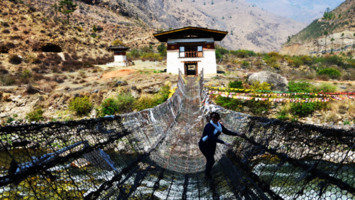
Embark on an epic Himalayan Adventure on this private tour covering places like Gangtok, Darjeeling, Thimphu, Paro and Punakha. This is a unique combination covering best of Eastern Himalayas in India and Bhutan. From lofty hillocks to winding roads accompanied by gushing rivers, nature in this part of region is at her purest best. Dominated by mesmerizing views of the Himalayas, this region offers visitors variety of natural beauty and cultural delights. For the most part of the tour, you would come across old, historical structures, monasteries, temples etc. Be it the beauty of the spectacular Himalayas and wide landscapes dotted with rice-fields or the magnificent architecture of age-old monasteries and houses, this tour is a treat for your eyes, mind, body and soul.
Brief Description of Cities
Kolkata - Also known as “City of Joy” - India’s second biggest city, Kolkata is regarded as India’s intellectual & cultural capital - Being former capital of British India, it retains it retains to colonial era charm - Several well-maintained major buildings from the colonial period have been declared "heritage structures"
Gangtok - The name Gangtok is derived from the Tibetan word for ‘hillside’, this capital city is the largest town of the Indian state of Sikkim - It also is the headquarters of the east Sikkim and located at an altitude of 1650 meters - The town’s one lac population belongs to different ethnicities such as Nepalese, Lepchas and Bhutias - Nestled within higher peaks of the Himalaya and enjoying a year round mild temperate climate.
Darjeeling - Darjeeling as the QUEEN OF HILL is a famous hill resort offering a breath taking sight of the numerous peaks of the majestic Himalayas - It is located in the Mahabharata Range or Lesser Himalaya at an average elevation of 6,710 ft. (2,045.2 m) - The views of Kanchenjunga and Mount Everest are particularly awe inspiring - The finest blend of tea comes from various tea gardens of this region.
Why the name Darjeeling? Did it ever strike you in the first place how the name Darjeeling was coined? Well there are several stories behind the name. The most popular is the one that says that Observatory Hill (located behind the Mall) which is the highest point in Darjeeling town, attracted lots of lightning and thunders. This is particularly so during the monsoon season. The word 'Dorji' in Tibetan means 'Thunderbolt' and 'Ling' means 'Place'. Therefore, Darjeeling was so named to mean 'The place of thunderbolt'. Another story says that the Tibetan monks built a monastery atop the Observatory Hill in 1763. The name of the chief monk of the monastery was Rinzing Dorji Legden La. The Tibetans named the place after him. Dorji-Ling meaning 'Place of Dorji', and hence the name Darjeeling. In Sanskrit, the word "Durjay Ling" means "Shiva of invincible prowess who rules the Himalayas." The name Darjeeling could have also been derived from this.
Phuentsholing: Border Town of Southern Bhutan - Has Headquarters of Bank of Bhutan - Thriving commercial center on the northern edge of the Indian Plains.
Thimphu: Capital and the largest city of Bhutan - Only capital city in the world that does not have traffic lights - Main center of Commerce, Religion and Government in the country - Most modern city of Bhutan and has abundance of restaurants, internet cafes, nightclubs and shopping center. It is one of the few cities of Bhutan having ATM facilities.
Paro: Small town in the western part of Bhutan - Also home to Paro Airport, Bhutan’s only International Airport - The valley has many isolated small villages and is known for red rice - Also home to most of Bhutan’s oldest temples and monasteries.
Punakha and Wangdue: Punakha and Wangdue is located in the same valley. These two places are located within a distance of 13 km. Punakha was the capital of Bhutan and the seat of government until 1955 - The valley is fed by the Pho Chhu and the Mo Chhu rivers - It is one of very few places in Bhutan which offers Rafting facilities - It is the winter seat of the Je Khenpo (Chief Abbot) and the monk body at present.
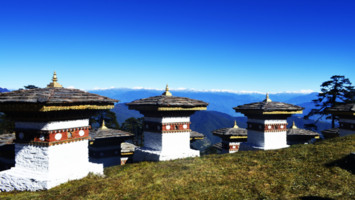
Experience the two great kingdoms great kingdom of the Himalayas - Nepal and Bhutan and their unique cultures and traditions on this rare itinerary with the Himalayan Experts. The Himalayan range containing some of the highest peaks of the world that has been remained great center of attractions for Adventure Seekers and explores. In a nutshell, Nepal is a land of geographic icons, historic adventurers and monumental landscapes. Its sits in the shadow of Everest but shines with myriad treasures. Whereas Bhutan is one of the world’s most traditional and culturally rich lands of the world. To the local people traditional values, environmental preservation and good governance takes precedence over material things.
Brief description of cities.
Kathmandu: Capital and largest municipality of Nepal – Located at a height of 1,400 m - surrounded by four major hills: Shivapuri, Phulchoki, Nagarjun, and Chandragiri – Hub of country’s economy
Pokhara: Second largest city of Nepal – Located 200 Kms from Kathmandu - Due to its proximity to the Annapurna mountain range, the city is also a base for trekkers undertaking the Annapurna Circuit through the ACAP region of the Annapurna ranges in the Himalayas.
Thimphu: Capital and the largest city of Bhutan - Only capital city in the world that does not have traffic lights - Main center of Commerce, Religion and Government in the country - Most modern city of Bhutan and has abundance of restaurants, internet cafes, nightclubs and shopping center. It is one of the few cities of Bhutan having ATM facilities.
Paro: Small town in the western part of Bhutan - Also home to Paro Airport, Bhutan’s only International Airport - The valley has many isolated small villages and is known for red rice - Also home to most of Bhutan’s oldest temples and monasteries.
Punakha and Wangdue: Punakha and Wangdue is located in the same valley. These two places are located within a distance of 13 km. Punakha was the capital of Bhutan and the seat of government until 1955 - The valley is fed by the Pho Chhu and the Mo Chhu rivers - It is one of very few places in Bhutan which offers Rafting facilities - It is the winter seat of the Je Khenpo (Chief Abbot) and the monk body at present.